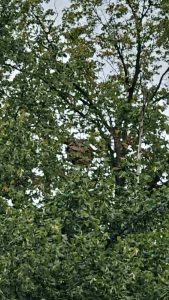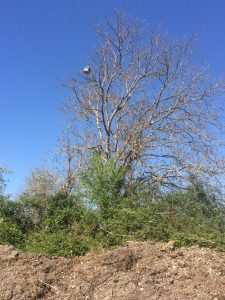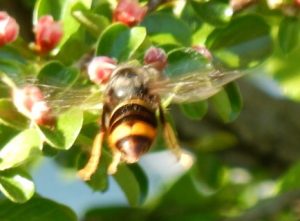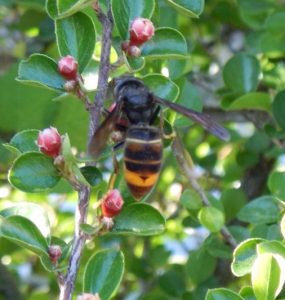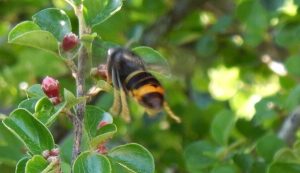Yellow-Legged Hornet Week update From Peter Davies NBU 2025
Yellow Legged Asian Hornets found in North Yorkshire
A Yellow Legged Asian Hornet nest has been found high up (~18m) in trees, in Langton, North Yorkshire. Langton villagers have been informed, posters put up and leafletting carried out in the nearby villages of Westow and Burythorpe. Monitoring stations are being established – an open example is shown in this video.
Representatives from the National Bee Unit have been on site to eliminate the nest(s). They can be hard to spot from ground level. Below is a photo zoomed in on the nest at Langton.
DNA testing is likely to be used for the Yellow-legged Asian hornet (Vespa velutina nigrithorax) to confirm its identification, determine its geographical origin, and assess genetic diversity to guide eradication and control strategies in the UK and Europe. Samples, often from nests, are sent to a specialized diagnostic laboratory like the Animal and Plant Health Agency (APHA) Fera laboratory for analysis, which includes methods like species-specific DNA assays and microsatellite analysis to understand relatedness to other nests and populations.
 New Film on Asian Hornets in France.
New Film on Asian Hornets in France.
There is a new film available on YouTube, which is well worth a viewing…thank you Adrian!! [You can skip the ads – it’s on YouTube!]
Leaflets from BBKA
There are free leaflets from BBKA on the Asian Hornet. Feel free to print these out and post them in you local shop!
This NNSS [Non-native Species Secretariat] leaflet is a guide on Yellow Legged Asian Hornet identification.
This leaflet is a guide on identification of the nest.
Asian Hornet Week from 1st-7th September 2025, is aimed at raising immediate public awareness at a time when the beasts may be a more visible.
 There is much more information and current updates on the BBKA website where there is a spotting sheet and materials to download. Ryedale Beekeepers Association have two pull up banners that can be used at local Shows and are happy to help with raising awareness of this pest.
There is much more information and current updates on the BBKA website where there is a spotting sheet and materials to download. Ryedale Beekeepers Association have two pull up banners that can be used at local Shows and are happy to help with raising awareness of this pest.
Asian Hornet Information on the Non-Native Species Secretariat website
Species Alert [see no nnativespecies.org]
nnativespecies.org]
Vespa velutina, also known as the Asian hornet is an invasive non-native species from Asia. It arrived in France in 2004 where it spread rapidly. As a highly effective predator of insects, including honey bees and other beneficial species, it can cause significant losses to bee colonies, and potentially other native species.
The National Bee Unit confirmed a sighting of the Asian hornet in the Tetbury area of Gloucestershire in September 2016 – the first time the hornet was discovered in the UK. The places it is most likely to be found are in southern parts of England or goods among which it could be accidentally imported [such as soil with imported pot plants, cut flowers, fruit and timber]. It is inactive over the winter.
RBKA will post news on occurrence and distribution in the UK as and when it is received. One of our members was actively involved in the recent reporting from Tetbury and the latest news will be available here!
What to look out for…
- Vespa velutina queens are up to 3 cm in length; workers up to 25 mm [slightly smaller than the native European hornet Vespa crabro]
- Entirely dark brown or black velvety body, bordered with a fine yellow band
- Only one band on the abdomen: 4th abdominal segment almost entirely yellow/orange
- Legs brown with yellow ends
- Head black with an orange-yellow face
- Vespa velutina is a day flying species which, unlike the European hornet [Vespa crabro], ceases activity at dusk
There are some excellent publications prepared by the Non-Native Species Secretariat [NNSS] and available on their website
- Poster showing key features NNSS Asian Hornet Poster
- Identification Sheet NNSS Asian Hornet Identification Sheet
- General Information Sheet NNSS Asian Hornet Information Sheet
This insect is not in Ryedale, yet….
..but it has been found in Yarm and Hull in 2023 !
If you should find yourself in the Dordogne region of France, near the market town of Riberac, there is every chance you will see Asian hornets. Even if you do not, there is a pest control operation based there called allo-3D [11, Place Nationale, 24600 Riberac] that has displays of cut-through nests and a host of current information. Did you know for example, that in this part of France at least, nests have been found at ground level in old tunnels left by moles? Talk to Elodie Cornu who is a beekeeper, speaks beautiful English [and French] and has a wealth of knowledge on current management practices and control strategies.
These pictures were taken on cotoneaster flowers at Mensignac in the Dordogne, where 4-5 hornets were seen feeding on a regular basis. A specimen of the European hornet was also captured at the same site.
And this is what you can do if you catch one…bottled hornet
*** New App for IOS and Android systems ***
An App for your mobile is now available. It has been developed by, and for, the Department for Environment, Food & Rural Affairs [DEFRA]. It is designed to be easy to use and allows fast reporting of possible Asian hornet sightings.
The interactive app, developed by the Great Britain Non-native Species Secretariat and the Centre for Ecology and Hydrology, will also make it easier for people to judge whether an insect may actually be an Asian hornet; with pictures available of other insects that it could be confused with and helpful information about their size, appearance and the times of year they are most likely to be spotted.
Martin Smith, Public Affairs Manager at the British Beekeepers’ Association, said: This new app launched today by DEFRA is a welcome addition to current reporting methods that have enabled beekeepers and members of the public to report possible sightings. The key to containment is catching outbreaks as early as possible and allowing fast tracking of the insects back to their nest. We will certainly be encouraging all our 25,000 beekeepers to install the app and use it if they see what might be an Asian hornet near their hives.
The Asian Hornet Watch app is available to download from the Apple and Android app stores.
What you can do about it…although it is not in Ryedale as yet…
Trapping is an option, and RBKA has prepared instructions for a sentinel trap based on a publication provided by the National Bee Unit. The RBKA Nelson Trap is a simplified, and we believe easier to construct, trap. It is uses cheap and readily available materials. This trap reduces damage to other species and is specific for the Asian Hornet. Instructions may be downloaded [RBKA Nelson Trap] or viewed online.
If you suspect you have caught an Asian hornet then send details, with a photograph and location information, by email to: alertnonnative@ceh.ac.uk or you may submit details online through this link – Hornet Sighting
Do NOT under ANY CIRCUMSTANCES disturb or provoke an active hornets’ nest [as if you need telling!!].
Interesting videos…
Please note that at the end of these videos, YouTube will follow-up with the next related video which may not be about Vespa velutina! To return to RBKA site press ESC.
Nest destruction in France…
A clip of Asian hornet hawking behaviour…
More from Italy…some fine photography

